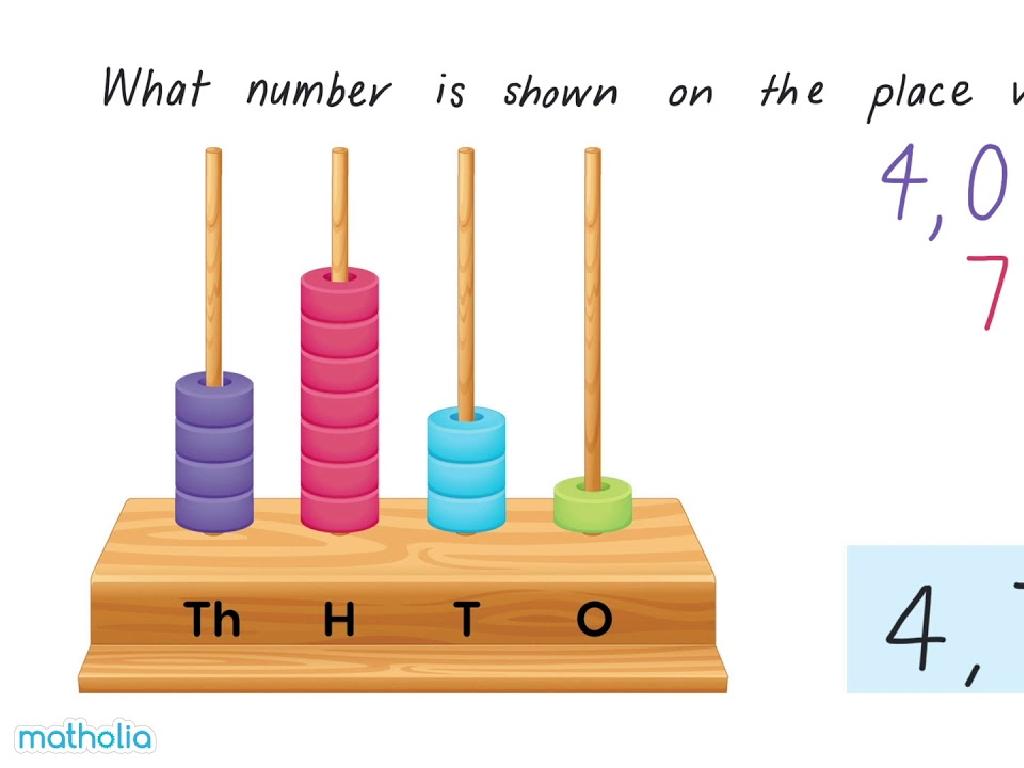Find Values Using Function Graphs
Subject: Math
Grade: Eighth grade
Topic: Function Concepts
Please LOG IN to download the presentation. Access is available to registered users only.
View More Content
Finding Values Using Function Graphs
– Understanding functions in math
– A function relates an input to an output
– Functions describe real-world situations
– E.g., temperature over a day, distance over time
– Today’s focus: Graphs of functions
– Visual representation of functions
– How to find values using graphs
– Locate a point on the graph to find a value
|
This slide introduces the concept of functions in mathematics and their practical application in describing real-world scenarios. Functions are fundamental in math as they establish a relationship between two variables, typically an input and an output. For example, they can represent how the temperature changes throughout the day or how distance varies with time. Today’s lesson will focus on interpreting function graphs, which are visual representations of these relationships. Students will learn how to find specific values by locating points on the graph, understanding the x (input) and y (output) coordinates, and how they correlate to real-world contexts. Encourage students to think of functions as a way to predict outcomes and analyze patterns. Provide examples and practice problems to solidify their understanding.
Understanding Functions in Math
– Define a mathematical function
– A function relates an input to exactly one output
– Functions: special value relationships
– Think of it as a machine: each input (x) gives a specific output (y)
– One input yields one output
– For example, in f(x) = x + 2, input 3 gives output 5
|
This slide introduces the concept of functions, which are fundamental in mathematics, especially in algebra. A function is defined as a special relationship where each input is related to exactly one output. It’s like a machine where you put in a number (input), and the machine gives you a number back (output). Emphasize that for every input there is only one possible output, which is a key property of functions. Use simple examples to illustrate this concept, such as f(x) = x + 2, and show how inputting a number into the function gives a single result. This sets the stage for understanding how to read and interpret function graphs.
Parts of a Function Graph
– Identify the x-axis (independent)
– The horizontal line where we plot input values
– Identify the y-axis (dependent)
– The vertical line where we plot output values
– Understand the function’s graph
– The curve or line represents the function’s behavior
– Interpret points on the graph
– Each point shows an output for a given input
|
This slide introduces students to the basic components of a function graph, which is a visual representation of a mathematical function. The x-axis, or horizontal axis, represents the independent variable, which is the input of the function. The y-axis, or vertical axis, represents the dependent variable, which is the output. The curve or line on the graph illustrates how the output values change in response to the input values. Students should learn how to read the graph to find the value of the function for any given value of the independent variable. Encourage students to practice by picking points on the graph and identifying the corresponding input and output values. This foundational skill will be crucial for understanding more complex concepts in algebra.
Reading Function Graphs
– How to read graph values
– Find output for a given input
– If x is 3, what is y on the graph?
– Interpret points on the graph
– Point (3,5) means when x is 3, y is 5.
– Practice with example graphs
– Use sample graphs to locate points and determine their values.
|
This slide introduces students to the concept of reading values from function graphs. Start by explaining how to identify the x (input) and y (output) axes. Demonstrate finding the output value for a given input by drawing a vertical line from the x-axis to the function and then a horizontal line to the y-axis. Provide clear examples by pointing out specific coordinates on the graph and explaining their meaning. Conclude with practice examples, using different function graphs to solidify the students’ understanding. Encourage students to ask questions if they’re unsure about how to read the graph.
Interpreting Real-World Graphs
– Apply graph interpretation to life
– Example: Car’s journey graph
– Distance vs. Time graph shows car speed over a trip
– Understand graph slope
– Slope indicates speed: Steeper means faster
– Relate slope to real scenarios
– Slope shows rate of change, like speed or growth
|
This slide aims to help students apply their knowledge of function graphs to real-life situations, enhancing their understanding of how mathematics is used in everyday contexts. For instance, a Distance vs. Time graph can illustrate a car’s journey, with the slope of the line representing the car’s speed. A steeper slope indicates a faster speed. Understanding the slope is crucial as it represents the rate of change in various scenarios, such as the rate of speed in this example or the growth rate in a business context. Encourage students to think of other real-world examples where a graph’s slope provides meaningful information. This will help solidify their grasp of the concept and its practical applications.
Graphing Functions: Practice Problems
– Work through example problems
– Identify inputs and outputs
– For a given x (input), find y (output) on the graph
– Approach complex graphs
– Break down steps to analyze parts of the graph
– Class activity: Practice session
– Students will solve different graph problems
|
This slide is designed to engage students in hands-on practice with function graphs. Start by solving example problems as a class to demonstrate the process. Emphasize the importance of identifying the input value (x) and locating the corresponding output value (y) on the graph. When discussing complex graphs, break down the graph into simpler parts and show how to analyze each section. For the class activity, provide a set of practice problems that require students to apply what they’ve learned. Differentiate the problems based on complexity to cater to varying skill levels. Encourage collaboration and peer discussion to facilitate learning. The teacher should circulate the room, offering guidance and ensuring that students are correctly interpreting the graphs.
Class Activity: Exploring Function Graphs
– Analyze graphs with multiple functions
– Identify values from function graphs
– Use the graph to find specific output values for given inputs
– Collaborate and compare findings
– Work in pairs to ensure accuracy and understanding
– Discuss results with the class
– Share your findings and methods with classmates
|
In this interactive class activity, students will be given graphs containing multiple functions to analyze. They will practice identifying specific values using these function graphs, which will help solidify their understanding of how functions behave visually. Students should pair up to compare their findings, promoting collaboration and peer learning. Afterward, they will discuss their results and methods with the class, allowing for a comprehensive review and reinforcing the learning objectives. As a teacher, facilitate the activity by providing guidance on how to read function graphs and ensure that each pair has a different set of functions to analyze. Possible activities include finding the y-value for a given x, determining the x-value when y is known, and identifying the points of intersection between functions.
Conclusion & Homework: Function Graphs Mastery
– Recap: Finding values on graphs
– Review how to read and interpret points on function graphs.
– Mastery is key for future math
– Understanding graphs is crucial for algebra and calculus.
– Homework: Function graph worksheet
– Complete the provided worksheet to practice skills.
– Bring questions to next class
|
This slide wraps up the lesson on finding values using function graphs and emphasizes the importance of mastering this skill for future mathematical concepts. Students should understand that being able to read and interpret function graphs is not only essential for their current studies but also forms a foundation for more advanced topics like algebra and calculus. For homework, students are assigned a worksheet that will allow them to apply what they’ve learned by interpreting various function graphs. Encourage students to attempt all problems and bring any questions they have to the next class for clarification. This will ensure they have a solid understanding of the topic.






